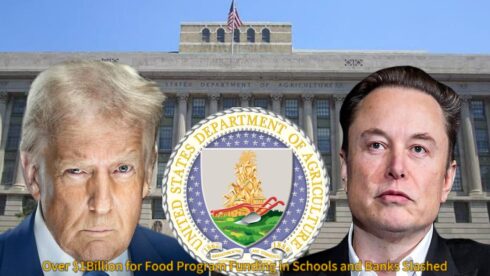The Trump administration has officially slashed over $1 billion in federal funding designated to help schools and food banks purchase food from local farmers. These cuts, which were communicated to multiple states by the U.S. Department of Agriculture, have sparked widespread concern among educators, food assistance programs, and agricultural organizations. The decision effectively eliminates the Local Food for Schools program, which was set to distribute $660 million in 2025 to support schools and food banks.
The funding was part of a broader initiative to ensure fresh, locally sourced food reached underserved communities while simultaneously bolstering small-scale farmers. However, the administration’s budget realignment priorities have redirected these funds elsewhere, leaving school districts and food banks scrambling to fill the gap. Many organizations that relied on these funds now face difficult decisions about how to maintain food supply levels without federal assistance.
Trump Administration Defunds Local Food Purchase Assistance Program
The Trump administration has also eliminated funding for the Local Food Purchase Assistance Cooperative Agreement Program, a vital initiative that connected small farmers with food banks and nonprofit organizations. This program was designed to create a direct pipeline between regional agriculture and communities struggling with food insecurity. Now, with funding abruptly halted, both farmers and food banks face a significant financial shortfall.
Without this support, many food banks will struggle to provide fresh, nutritious produce to low-income families. Small farms, which depended on these guaranteed government purchases, will need to find alternative buyers or risk severe financial distress. Critics argue that these cuts will exacerbate food insecurity and disproportionately impact rural communities, where local farms play a crucial economic role.
Trump Administration Prioritizes Government Spending Cuts Over Food Programs
The Trump administration has justified these cuts as part of a larger effort to reduce government spending and improve efficiency. Reports indicate that the decision to slash funding is linked to the Department of Government Efficiency (DOGE), an initiative championed by President Trump and entrepreneur Elon Musk. The goal of DOGE is to streamline federal expenditures, though opponents argue that these cuts are disproportionately affecting vulnerable populations.
While the administration claims that reducing food program spending is necessary to balance the budget, critics point out that other areas, such as military spending, have seen increases. The administration’s decision to prioritize cuts in food assistance programs over other budget items has fueled debate over the ethical and economic implications of these policies.
Trump Administration Budget Cuts Force Nonprofits to Reduce Services
The Trump administration’s budget cuts have already begun affecting nonprofit organizations that rely on federal grants to operate food distribution programs. In San Diego County, for example, multiple nonprofits have reported staff reductions and service cutbacks due to federal funding freezes. Many organizations that serve low-income families are now seeking alternative sources of funding to continue their operations.
According to a survey conducted by the Nonprofit Institute at the University of San Diego, nearly one-third of nonprofit organizations have been forced to modify or reduce services. Food banks, in particular, are among the hardest hit, as they had heavily depended on the Local Food Purchase Assistance Program to supply fresh produce to needy families. The loss of this funding means that many organizations will have to turn to private donations or state-level initiatives to compensate for the shortfall.
Trump Administration Shrinks Department of Education Workforce
The Trump administration has also overseen significant workforce reductions in the Department of Education, with nearly half of the department’s employees—approximately 1,300 workers—set to be laid off. Secretary of Education Linda McMahon announced these cuts as part of the administration’s plan to shift more educational responsibilities to state governments.
The layoffs have sparked concerns about how the department will manage federal education programs and funding oversight. With fewer employees, there may be delays in grant disbursement and program implementation, further complicating efforts to support schools that rely on federal assistance. Many educators and policy analysts warn that these cuts could weaken public education and make it harder for schools to access crucial resources.
Trump Administration Faces Opposition in Senate Over Budget Plan
The Trump administration‘s budget cuts have led to fierce opposition from Senate Democrats, who have vowed to block a Republican-led funding bill that includes substantial reductions to non-defense spending. The House of Representatives recently passed the bill, which slashes $13 billion from non-defense programs while increasing military funding by $6 billion. Senate Majority Leader Chuck Schumer has called the bill “unacceptable” and signaled that Democrats will push for amendments to restore funding to critical services.
One of the most controversial aspects of the bill is a provision requiring Washington, D.C., to cut its budget by $1 billion, a move that has drawn criticism from local officials. The battle over federal spending priorities is likely to continue in the coming weeks, with both parties preparing for a high-stakes negotiation over government funding.
These budget cuts and policy changes mark a significant shift in federal priorities under the Trump administration, with widespread implications for education, food security, and local economies. While supporters argue that the reductions are necessary for fiscal responsibility, opponents warn that they could lead to increased hardship for vulnerable communities across the country.














